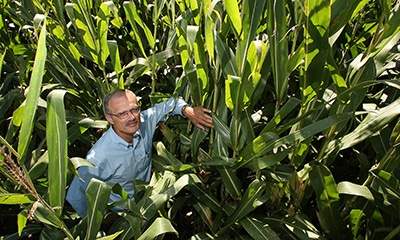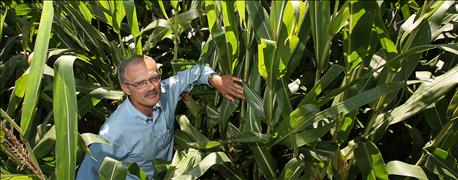July 19, 2016

Earlier this year, Farm Progress reported findings of a Purdue University study that modern corn hybrids can take up more nitrogen and convert it to yield later in the growing season – even later than the traditional knee-high sidedressing time.
In brief, corn hybrids released after 1990 are more resilient than their predecessors in multiple ways. Modern hybrids maintain per-plant yield in environments with low nitrogen. They can also bounce back from mid-season stress. They also have improved ability to take up N after silking, even if they suffered from N deficiency during pollination.

N PICKER-UPPER: Even silking corn may benefit from extra N, if you can figure out how to apply it, suggests Tony Vyn. Purdue University photo
So reserving a portion of nitrogen fertilizer to apply later in the season could be a good bet, says Purdue Agronomist Tony Vyn. It’s like insurance. You don't want to inadvertently cause N deficiency. But that risk, with modern hybrids, is also lower, he adds.
Nitrogen is an essential building block of plant proteins and plays a vital role in boosting grain yields. It's also notoriously mobile, notes Sarah Mueller, a Purdue doctoral student in agronomy and first author of the study. "Once that nitrogen is in the soil, you start losing it," she points out.
Modern hybrids do more with less
They maintain grain yield on a per plant basis even when planted at higher densities than their predecessors – averaging 30,000 plants per acre compared with 20,000 – despite average N fertilizer application rates remaining the same.
They also take up a substantial amount of new N during grain development – about 36% of total nitrogen uptake after silking, compared with about 30% in older hybrids.
So is a split-application approach with a late-season treatment a viable option? "These fundamental genetic changes could give us the opportunity for more flexibility in timing N applications," responds Vyn. "We're researching this further because there could be gains in N fertilizer efficiency that could improve corn productivity and benefit the environment."
Bottom line: Vyn and Mueller caution growers to not shortchange N applications, trusting modern hybrids to recuperate. Instead, think about how reserving some N for later might prove advantageous in both optimum and adverse growing conditions.
You May Also Like




